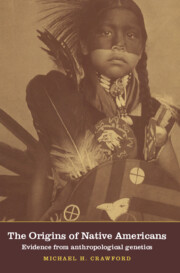Book contents
- Frontmatter
- Contents
- Preface
- Acknowledgement
- 1 Origins of New World populations
- 2 Population size and the effects of European contact
- 3 Demography of Amerindian populations
- 4 Genetic variation in contemporary populations of the Americas
- 5 Population structure of Native Americans
- 6 Morphological variation
- 7 The survivors
- References
- Author index
- Subject index
1 - Origins of New World populations
Published online by Cambridge University Press: 01 May 2010
- Frontmatter
- Contents
- Preface
- Acknowledgement
- 1 Origins of New World populations
- 2 Population size and the effects of European contact
- 3 Demography of Amerindian populations
- 4 Genetic variation in contemporary populations of the Americas
- 5 Population structure of Native Americans
- 6 Morphological variation
- 7 The survivors
- References
- Author index
- Subject index
Summary
INTRODUCTION
To the best of our knowledge, the aboriginal inhabitants of the Americas were initially contacted by Europeans in the eleventh century AD during Viking voyages of exploration. It is well documented historically that Norsemen had charted lands located to the west of Greenland, and that they referred to the landmass as Vinland. Apparently, the Vikings visited Vinland to collect lumber and established a settlement. Archeological evidence locates a Viking settlement at the L'Anse au Meadow site in Newfoundland. However, these first European settlers failed to permanently colonize this region of North America and either returned to Iceland or were massacred by hostile local inhabitants.
On 12 October 1492, Columbus, while searching for a route to the East Indies, set foot on the so-called New World (San Salvador, in what is now the Bahamas). He paraded the captive ‘Indians’ before the Spanish court and with the support of the Spanish Crown and Papal blessing brought Europeans to the New World in search of gold and spices. These European adventurers encountered a large native population that was distributed over a massive geographical expanse from the Arctic regions of North America through the Amazonian forests of Brazil to the bleak landscape of Tierra del Fuego, South America. These aboriginal populations practiced a wide variety of subsistence patterns, ranging from hunting and gathering, to fishing, to intensive agriculture. In some regions, such as the highlands of Mexico and Peru, their agricultural technology was highly sophisticated and sustained dense populations that developed civilizations rivaling those of Europe at that time. The origins of these ‘mysterious’ peoples of the New World perplexed the intelligentsia of Europe for many centuries.
- Type
- Chapter
- Information
- The Origins of Native AmericansEvidence from Anthropological Genetics, pp. 1 - 31Publisher: Cambridge University PressPrint publication year: 1998



